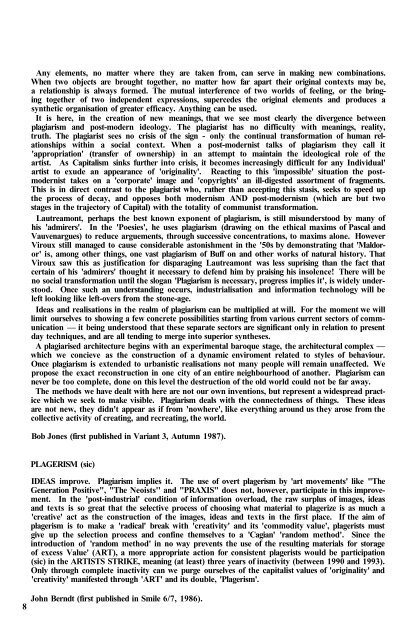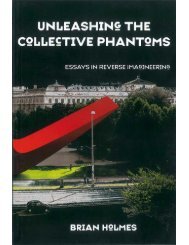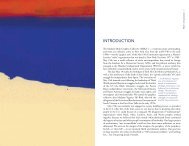Plagiarism: Art As Commodity and Strategies for ... - El plagio literario
Plagiarism: Art As Commodity and Strategies for ... - El plagio literario
Plagiarism: Art As Commodity and Strategies for ... - El plagio literario
You also want an ePaper? Increase the reach of your titles
YUMPU automatically turns print PDFs into web optimized ePapers that Google loves.
Any elements, no matter where they are taken from, can serve in making new combinations.<br />
When two objects are brought together, no matter how far apart their original contexts may be,<br />
a relationship is always <strong>for</strong>med. The mutual interference of two worlds of feeling, or the bringing<br />
together of two independent expressions, supercedes the original elements <strong>and</strong> produces a<br />
synthetic organisation of greater efficacy. Anything can be used.<br />
It is here, in the creation of new meanings, that we see most clearly the divergence between<br />
plagiarism <strong>and</strong> post-modern ideology. The plagiarist has no difficulty with meanings, reality,<br />
truth. The plagiarist sees no crisis of the sign - only the continual trans<strong>for</strong>mation of human relationships<br />
within a social context. When a post-modernist talks of plagiarism they call it<br />
'appropriation' (transfer of ownership) in an attempt to maintain the ideological role of the<br />
artist. <strong>As</strong> Capitalism sinks further into crisis, it becomes increasingly difficult <strong>for</strong> any Individual'<br />
artist to exude an appearance of 'originality'. Reacting to this 'impossible' situation the postmodernist<br />
takes on a 'corporate' image <strong>and</strong> 'copyrights' an ill-digested assortment of fragments.<br />
This is in direct contrast to the plagiarist who, rather than accepting this stasis, seeks to speed up<br />
the process of decay, <strong>and</strong> opposes both modernism AND post-modernism (which are but two<br />
stages in the trajectory of Capital) with the totality of communist trans<strong>for</strong>mation.<br />
Lautreamont, perhaps the best known exponent of plagiarism, is still misunderstood by many of<br />
his 'admirers'. In the 'Poesies', he uses plagiarism (drawing on the ethical maxims of Pascal <strong>and</strong><br />
Vauvenargues) to reduce arguements, through successive concentrations, to maxims alone. However<br />
Viroux still managed to cause considerable astonishment in the '50s by demonstrating that 'Maldoror'<br />
is, among other things, one vast plagiarism of Buff on <strong>and</strong> other works of natural history. That<br />
Viroux saw this as justification <strong>for</strong> disparaging Lautreamont was less suprising than the fact that<br />
certain of his 'admirers' thought it necessary to defend him by praising his insolence! There will be<br />
no social trans<strong>for</strong>mation until the slogan '<strong>Plagiarism</strong> is necessary, progress implies it', is widely understood.<br />
Once such an underst<strong>and</strong>ing occurs, industrialisation <strong>and</strong> in<strong>for</strong>mation technology will be<br />
left looking like left-overs from the stone-age.<br />
Ideas <strong>and</strong> realisations in the realm of plagiarism can be multiplied at will. For the moment we will<br />
limit ourselves to showing a few concrete possibilities starting from various current sectors of communication<br />
— it being understood that these separate sectors are significant only in relation to present<br />
day techniques, <strong>and</strong> are all tending to merge into superior syntheses.<br />
A plagiarised architecture begins with an experimental baroque stage, the architectural complex —<br />
which we concieve as the construction of a dynamic enviroment related to styles of behaviour.<br />
Once plagiarism is extended to urbanistic realisations not many people will remain unaffected. We<br />
propose the exact reconstruction in one city of an entire neighbourhood of another. <strong>Plagiarism</strong> can<br />
never be too complete, done on this level the destruction of the old world could not be far away.<br />
The methods we have dealt with here are not our own inventions, but represent a widespread practice<br />
which we seek to make visible. <strong>Plagiarism</strong> deals with the connectedness of things. These ideas<br />
are not new, they didn't appear as if from 'nowhere', like everything around us they arose from the<br />
collective activity of creating, <strong>and</strong> recreating, the world.<br />
Bob Jones (first published in Variant 3, Autumn 1987).<br />
PLAGERISM (sic)<br />
IDEAS improve. <strong>Plagiarism</strong> implies it. The use of overt plagerism by 'art movements' like "The<br />
Generation Positive", "The Neoists'' <strong>and</strong> "PRAXIS" does not, however, participate in this improvement.<br />
In the 'post-industrial' condition of in<strong>for</strong>mation overload, the raw surplus of images, ideas<br />
<strong>and</strong> texts is so great that the selective process of choosing what material to plagerize is as much a<br />
'creative' act as the construction of the images, ideas <strong>and</strong> texts in the first place. If the aim of<br />
plagerism is to make a 'radical' break with 'creativity' <strong>and</strong> its 'commodity value', plagerists must<br />
give up the selection process <strong>and</strong> confine themselves to a 'Cagian' 'r<strong>and</strong>om method'. Since the<br />
introduction of 'r<strong>and</strong>om method' in no way prevents the use of the resulting materials <strong>for</strong> storage<br />
of excess Value' (ART), a more appropriate action <strong>for</strong> consistent plagerists would be participation<br />
(sic) in the ARTISTS STRIKE, meaning (at least) three years of inactivity (between 1990 <strong>and</strong> 1993).<br />
Only through complete inactivity can we purge ourselves of the capitalist values of 'originality' <strong>and</strong><br />
'creativity' manifested through 'ART' <strong>and</strong> its double, 'Plagerism'.<br />
John Berndt (first published in Smile 6/7, 1986).<br />
8






